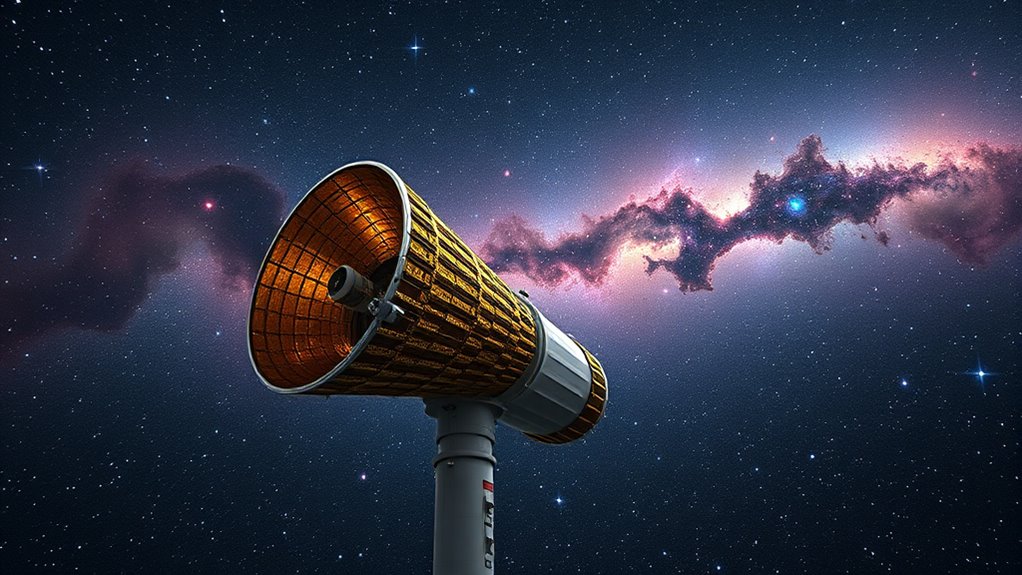In 2025, the James Webb Telescope made incredible discoveries that reshape our view of the universe. You’ve learned about new insights into galaxy formation, uncovering how the first stars ignited, and detecting exoplanet atmospheres that could support life. These breakthroughs help answer big questions about cosmic origins and evolution. If you keep exploring, you’ll uncover even more fascinating details about how our universe develops and what lies beyond our current knowledge.
Key Takeaways
- Webb identified water vapor and gases like methane in exoplanet atmospheres, indicating potential habitability.
- It uncovered insights into galaxy formation, revealing how early galaxies assembled and evolved over cosmic time.
- Webb detected signals from the universe’s first stars and stellar nurseries, illuminating the universe’s formative years.
- The telescope refined cosmological models by analyzing dark matter distribution and cosmic inflation processes.
- Webb’s ongoing observations continue to deepen understanding of the universe’s origins and cosmic evolution.

Have you ever wondered how scientists glimpse the earliest moments of our universe? The James Webb Telescope has revolutionized this pursuit, opening a window into distant cosmic phenomena. One of its most exciting capabilities is analyzing exoplanet atmospheres, which allows researchers to identify the presence of water vapor, methane, and other gases that could hint at habitability. By examining the chemical compositions of these atmospheres, Webb helps us understand whether planets outside our solar system could support life. This is a game-changer, as it moves us beyond merely detecting exoplanets to exploring their potential for life.
Webb’s analysis of exoplanet atmospheres reveals water vapor and gases, opening new frontiers in the search for extraterrestrial life.
But Webb’s discoveries go far beyond individual planets. It has provided invaluable insights into galaxy formation, revealing how the universe built itself up over billions of years. With its powerful infrared sensors, it can peer through cosmic dust clouds that once obscured our view, allowing us to observe galaxies in their infancy. These observations show us how the earliest galaxies assembled, merged, and evolved into the massive structures we see today. By analyzing the light from these distant galaxies, Webb helps fill in the gaps of our cosmic timeline, shedding light on the processes that shaped the universe after the Big Bang.
In addition to its focus on exoplanets and galaxy formation, Webb has uncovered evidence of the first stars igniting in the universe. Its ability to detect faint infrared signals has revealed stellar nurseries teeming with newborn stars, giving us a glimpse into the universe’s formative years. These discoveries help scientists piece together the complex sequence of events that led to the formation of galaxies and planetary systems, including our own solar system. Webb’s detailed observations enable us to understand how matter coalesced and how different cosmic structures interacted over time.
Moreover, Webb’s findings are helping refine our models of the universe’s evolution. By comparing real data with theoretical predictions, scientists can improve their understanding of fundamental processes like dark matter distribution and cosmic inflation. This ongoing research not only answers longstanding questions but also sparks new ones, driving the field of astrophysics forward. Additionally, Webb’s ability to analyze the composition of exoplanet atmospheres enhances our understanding of planetary habitability and the potential for extraterrestrial life.
In essence, the James Webb Telescope is transforming our understanding of the cosmos. From analyzing exoplanet atmospheres to unraveling the story of galaxy formation, it’s revealing the universe’s secrets in unprecedented detail. As it continues to operate, you can expect even more extraordinary discoveries that bring us closer to understanding our origins and our place in the universe.
Frequently Asked Questions
How Does the James Webb Telescope Differ From Hubble?
You’ll find that the James Webb Telescope differs from Hubble mainly because it’s a space-based observatory designed for infrared astronomy. This allows Webb to see through cosmic dust and observe distant galaxies, stars, and planets in unprecedented detail. While Hubble primarily observes in visible and ultraviolet light, Webb’s infrared capabilities give you a deeper look into the universe’s early history, making it a powerful tool for exploring the cosmos.
What Challenges Did Webb Face During Its Deployment?
You thought deploying the Webb was smooth sailing? Think again. It faced endless deployment delays and technical hurdles, turning a straightforward launch into a cosmic drama. From unfolding its massive mirror to aligning instruments, every step was riddled with challenges. Despite these setbacks, perseverance paid off, and now you get to marvel at the universe’s secrets — all thanks to overcoming those initial cosmic hiccups.
Can Webb Detect Life Beyond Earth?
Yes, Webb can help detect life beyond Earth by analyzing exoplanet atmospheres for astrobiology prospects and extraterrestrial biosignatures. You’ll see it examine gases like oxygen, methane, and water vapor, which could indicate biological activity. While it can’t directly observe life, Webb’s sensitive instruments can identify signs that suggest the presence of extraterrestrial life, advancing our understanding of potential habitats and the possibility of life elsewhere in the universe.
How Does Webb Contribute to Understanding Dark Matter?
You can see how Webb contributes to understanding dark matter through its advanced cosmic structure analysis and dark matter detection capabilities. By observing the distribution of galaxies and gravitational lensing effects, you gain insights into dark matter’s role in shaping the universe. Webb’s infrared observations help detect the influence of dark matter on cosmic formations, bringing you closer to unraveling this elusive component of the universe.
What Are the Future Missions Planned for Webb?
You’re in for a treat as Webb’s future missions aim to unlock cosmic evolution and planetary atmospheres. It plans to observe the earliest galaxies, shedding light on how the universe evolved. Webb will also study exoplanets in detail, analyzing their atmospheres for signs of habitability. These missions will keep pushing boundaries, helping you understand the universe’s grand story while you watch from the sidelines.
Conclusion
As you reflect on the James Webb Telescope’s groundbreaking discoveries of 2025, it’s clear that the universe’s secrets are finally within our grasp. Like a lighthouse guiding us through cosmic darkness, Webb illuminates mysteries once thought unreachable. These revelations don’t just expand our knowledge—they ignite our imagination and curiosity. As we stand on the brink of new horizons, one thing’s certain: the universe’s story is far from over, and Webb is leading us toward its next chapter.









